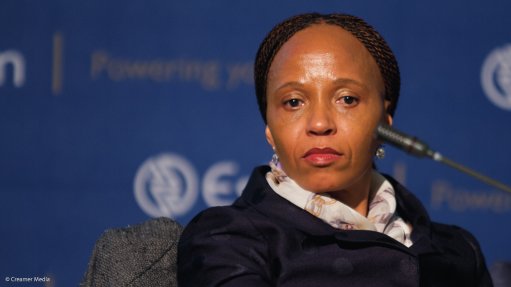
Eskom FD Tsholofelo Molefe
Photo by: Duane Daws
State-owned electricity producer Eskom has confirmed that it has handed its ‘comprehensive sustainability plan’ to Public Enterprises Minister Lynne Brown, who is a key participant in an inter-Ministerial process set up to deal with the utility’s financial problems.
Eskom claims to be facing a R225-billion revenue shortfall as a result of having been granted five yearly tariff increases of 8% between 2013 and 2018 by the National Energy Regulator of South Africa (Nersa) instead of the 16% it had requested.
Interim CEO Collin Matjila says components of the plan, including a business productivity programme, are already being implemented.
However, there are elements, including a possible further capital injection, that require a determination from the task team, comprising the National Treasury, the Department of Public Enterprises and the Department of Energy. This task team, in turn, will need to have any plan sanctioned by Cabinet.
The sustainability plan was handed to Brown at the group’s annual general meeting on July 11 and outlines Eskom’s response to its short-term liquidity challenges and long-term financial sustainability.
FD Tsholofelo Molefe indicates that the plan is premised on ensuring that the utility receives an appropriate return on assets in the long term, while securing adequate funding to address liquidity in the short term.
During its 2013/14 financial year, Eskom reported a R7.1-billion net profit. However, it also reported a negative 0.53% pre-tax real rate of return on assets, well below its pre-tax real cost of capital of 7.65%.
The utility has raised around R255-billion of the R300-billion in debt funding it requires to build new generation and transmission capacity. This debt needs to be repaid by 2052, but Eskom already had net interest repayments of R9-billion last year.
Molefe says long-term financial sustainability will not be achieved through efficiencies and savings alone and that a transition to cost-reflective tariffs remains imperative.
But given public resistance to higher tariffs, Eskom and government are investigating alternative sources of funding, including possible equity or quasi-equity instruments – a figure of R50-billion has been mooted, but not confirmed.
Also being explored are additional borrowing options above the R300-billion targeted. But Molefe stresses that its ability to borrow at affordable levels is constrained, particularly in light of a recent credit-rating downgrade and the risk of a further downgrades.
Capital expenditure within the R251-billion budget is also being reprioritised, and Eskom has made a regulatory clearing account (RCA) application to Nersa in a bid to “claw back prudently incurred expenditure and lost revenue due to lower demand than forecast in the second multiyear price determination (MYPD2) application”. The MYPD2 period covered the three years from 2010 to 2013.
Nersa is expected to make a call on the MYPD2 RCA application this month, which could affect tariffs as from April 1, 2015.
Once the MYDP2 RCA application is finalised, Eskom is expected to begin making follow-up applications for the MYPD3 control period, which is now in its second year.
“Critical for Eskom is ensuring a balance between security of supply, asset creation, financial sustainability and environmental compliance and to responsibly manage the trade-offs that are required,” Molefe says.